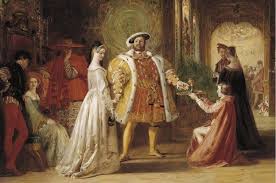This is what we want! A bit of spicy 16th Century gossip, courtesy of our royal affairs correspondent Angus Young. Off with his head!

It’s a question historians have been puzzling over for centuries. Did they or didn’t they? To this day, opinion remains divided over whether King Henry VIII’s fifth wife Catherine Howard was having a secret affair with her husband’s confidant Thomas Culpeper as they headed to Hull in the autumn of 1541.
Until then, the 50-year-old monarch had never been further north than Boston in Lincolnshire. However, in June that year Henry and his relatively new teenage bride embarked on a four-month journey to the North of England, known as a Royal Progress. The travelling party included half of the Privy Council and an entourage of 4,000 horsemen, soldiers and servants which stretched over a mile. Henry’s intention was to remind the North of his power, having previously crushed a rebellion protesting at his dissolution of the monasteries.
The Progress ultimately headed for York but not before a visit to Hull with Henry and Catherine staying at Wressle Castle near Howden before another overnight stop at Leconfield Castle near Beverley. From Leconfield, Henry and his court travelled to Hull and stayed at the Manor House which he happened to own. While in the town, Henry approved plans for new defensive fortifications and came up with his own proposals to re-design the Manor House.

After going to York, Henry returned to Hull in late September to force the resignation of the newly-elected Mayor and oversee the election of his own preferred choice for the post, Sir John Elland. During this second visit it’s thought Catherine stayed either in Wressle or Leconfield while Henry was accompanied by his Privy Councillors, including Culpeper. By then, whispers about an illicit relationship between the Queen and Culpeper were starting to circulate.
The Royal party returned to Hampton Court on October 24. Just over a week later the Archbishop of Canterbury Thomas Cranmer delivered a note to Henry suggesting Catherine was not the virgin bride he thought she was having slept with Francis Dereham, another royal courtier. The king refused to believe it but ordered a secret investigation to discover the truth. Dereham was arrested, confessed and then implicated Culpeper.
The man who was at Henry’s side in Hull just a month earlier admitted an intention to marry Catherine after the death of the king. For her part, Catherine admitted having secret meetings with Culpeper during the Progress but denied adultery. Most historians now believe the pair didn’t actually do the dirty deed but would have done so given the chance.
On December 1 Culpeper and Dereham pleaded guilty to treason. Ten days later Culpeper was beheaded before Dereham was hung, drawn and quartered in a double execution at Tyburn. Their heads were subsequently placed on spikes on London Bridge. Two months later Catherine passed under the same bridge as she was taken by boat to the Tower of London and a date with the executioner’s axe.
As Sid James said later in Carry on Henry: “Cor blimey!”

